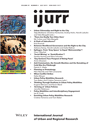In the past two decades, the Berlin district of Neukölln has received considerable attention from politicians, planners, urban scholars and the media. This article discusses the role that the academic concepts of ‘social mixing’ and ‘gentrification’ play in the overlapping and partly contradictory narratives that have been employed to interpret transformations in one particular part of the district, Nord-Neukölln. While the area is still characterized as a place of poverty and decline, it has more recently come to be known as a ‘hip place to be’ among young (creative) urbanites, students and artists. Various urban players such as politicians, planners, urban sociologists, activists, interest groups and the media participate in the construction of these narratives and, in the process, adopt the concepts of social mixing and gentrification according to their respective rationales and preferences. Both concepts play a pivotal role in justifying contradictory claims and interventions. As a consequence, ‘social mixing’ and ‘gentrification’ are more than just analytical concepts for interpreting urban transformations; they have themselves become part of these transformations and have an impact on local developments. We conclude that urban scholarship must reflect more on its own role and positioning in the arena of urban transformation.
Details
Written by:
Sandra Huning and Nina Schuster
Digital Object Identifier (DOI)
10.1111/1468-2427.12280
About DOI

